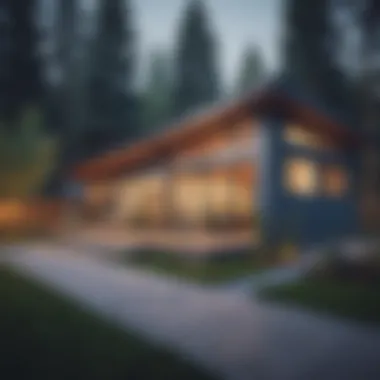Understanding Costs of Accessory Dwelling Units


Intro
In the world of real estate, the Accessory Dwelling Unit (ADU) has gained considerable momentum. Homeowners, investors, and policy makers alike are increasingly recognizing the multifaceted benefits these units can offer. However, diving headfirst into ADU construction demands a robust understanding of the costs involved. This article takes you through a detailed analysis aimed at demystifying those expenses.
Understanding the pricing dynamics of ADUs is not merely a task for accountants or real estate analysts; it’s vital knowledge for any concerned party aiming to make strategic financial decisions. Whether you're eyeing a cozy studio in your backyard or a more elaborate two-bedroom unit perched above your garage, each step requires discernment.
Let’s break down the critical elements that contribute to the overall costs and help you navigate this burgeoning segment of the housing market efficiently.
Investment Definitions
Understanding the fundamental terms and concepts surrounding ADUs is crucial. Here we'll clarify key terms and highlight some common investment strategies related to ADU construction.
Key Terms Explained
- Accessory Dwelling Unit (ADU): A secondary housing unit located on the same lot as a primary residence, often referred to as a mother-in-law suite, backyard cottage, or garage apartment.
- Zoning Regulations: Local government rules that dictate how land can be used and including whether ADUs are permitted.
- Return on Investment (ROI): A measure used to evaluate the efficiency of an investment, particularly valuable in assessing the potential profitability of building an ADU.
Common Investment Strategies
- Long-Term Rental: Utilizing your ADU for sustained rental income can provide steady cash flow. This route often leads to a more substantial return compared to short-term vacation rentals.
- Short-Term Listing: Platforms like Airbnb or VRBO allow homeowners to capitalize on short-term stays, sometimes resulting in higher earnings but with varying occupancy rates.
- Living Space for Family: Designing it as a personal space for relatives can not only save money but also reinforce family bonds.
Expert Advice
Expert insights can illuminate the path for both novice and seasoned investors. Here are a few tips tailored for both groups to enhance their understanding of ADU investments.
Tips for Novice Investors
- Research Local Laws: Begin with a deep dive into your municipality’s stance on ADUs to avoid costly surprises down the road.
- Budget Wisely: Keeping a close eye on construction costs, utility setup, and even furnishing your unit is critical; an all-inclusive budget helps prevent unexpected expenses.
Advanced Strategies for Seasoned Investors
- Leverage Financing Options: Explore various funding routes, including home equity lines of credit (HELOCs) or government grants for sustainable housing, to optimize your budget.
- Partner with Local Organizations: Networking with local builders, real estate agencies, and community groups can lead to valuable insights and collaboration opportunities.
It is essential not only to think about the present costs but also to consider the long-term value an ADU can add to your property.
"Considering an ADU is not just about immediate gains; it’s about shaping your property’s future value and flexibility."
Ultimately, the landscape of ADUs presents a tangle of opportunities and pitfalls. This guide aims to equip you not just with knowledge, but with the perspective needed to navigate this growing sector.
Whether you're in the market for an investment or simply exploring options to expand your living spaces, these insights pave a pathway towards informed decision-making in this evolving domain.
Understanding Accessory Dwelling Units
Understanding Accessory Dwelling Units (ADUs) is crucial for any homeowner, investor, or policymaker keen on delving into modern housing trends. The demand for affordable housing solutions has skyrocketed, and ADUs present an innovative means to address this. ADUs serve multiple purposes, from providing rental income to accommodating family members, thereby enhancing a property’s utility.
When exploring this topic, several elements come into play. First, the sheer flexibility of ADUs allows homeowners to adapt their properties to their personal needs. Second, they can significantly enhance the value of a home both in the short and long term, turning an ordinary property into a multifaceted asset. However, there are considerations to keep in mind, such as local zoning laws, construction costs, and potential impacts on neighborhood dynamics.
As we navigate the ins-and-outs of ADUs, understanding their fundamental aspects lays the groundwork for a deeper exploration of construction costs, financing options, and regulatory hurdles.
Definition and Purpose
Accessory Dwelling Units are independent living spaces that are located on the same lot as a single-family home. Sometimes called granny flats or in-law units, these spaces offer a range of functionalities. The primary purpose of an ADU is to provide affordable, flexible housing solutions. They can house relatives, establish a separate living space for young adults, or serve as rental units contributing to a homeowner's income stream. This versatility is part of what makes ADUs so appealing.
Types of ADUs
Understanding the different types of ADUs helps in determining which option best suits personal or investment goals.
Detached Units
Detached Units are stand-alone structures built on the property, separate from the main house. One key characteristic of Detached Units is their independence. This feature makes them popular for individuals seeking privacy from the main home. They can be customized fully, offering unique architectural opportunities that appeal to various tastes. However, it's worth noting that building a Detached Unit could incur higher construction costs compared to other types.
Advantages:
- Privacy: They are entirely separate, providing a conducive environment for both parties.
- Rental Income: This setup is ideal for generating passive income without intruding upon main household activities.
Disadvantages:
- Higher Initial Investment: The construction costs can be substantial, requiring careful budgeting.
Attached Units
Attached Units are integrated into the existing home structure. They offer easier access to communal areas like kitchens or backyards, making them an excellent choice for families. Their nature often means lower construction and permitting costs than Detached Units because they share some existing infrastructure.
Advantages:
- Cost-Effective: Typically requires less investment and permits than a Detached Unit.
- Closer Family Cohesion: Easy access to the main living area can be beneficial for those wishing to stay close to family.
Disadvantages:


- Less Privacy: Living space is shared, which may not be ideal for everyone.
Conversions
Conversions refer to repurposing existing structures—such as garages or basements—into living spaces. This option is particularly appealing in urban settings where space is limited. One standout characteristic of Conversions is their cost-effectiveness, as they often require fewer resources compared to new construction.
Advantages:
- Lower Costs: Often less expensive than building new units due to reduced construction needs.
- Quick Implementation: Tends to have shorter timelines for completion, allowing for faster rental availability.
Disadvantages:
- Zoning Restrictions: Transforming a space may face regulatory hurdles, which is important to research and navigate.
In summary, the various types of Accessory Dwelling Units provide different avenues to enhance property value and meet housing demands. Each type comes with a set of benefits and challenges that potential homeowners and investors must evaluate carefully. Understanding these distinctions is paramount in embarking on an ADU project.
Factors Influencing ADU Costs
Understanding the elements that influence the costs of Accessory Dwelling Units (ADUs) is crucial for anyone looking to delve into this area of real estate. The expenditures associated with ADUs are not solely dictated by their size and design; they also hinge on a myriad of factors like location, materials, and even local regulations. By comprehensively examining these elements, homeowners, investors, and builders can better anticipate costs and make informed financial decisions that align with their goals.
Location and Land Use Regulations
The cost of constructing an ADU can swing dramatically based on its geographical location. Different regions come with varying land use regulations that dictate what can and cannot be built. For instance, in some areas, zoning laws allow for the construction of ADUs, while in others, they may be outright prohibited or heavily restricted.
Moreover, local policies on density, height restrictions, and setbacks can throw a wrench in plans. A homeowner looking to add an ADU in San Francisco, where space is tight and regulations are stringent, might face higher costs and lengthy procedures compared to someone in a less densely populated area.
It's vital to research zoning laws, engage with local planners, and possibly join community forums to get a grasp of how these rules may affect your project. This preemptive approach can save both time and money in the long run.
Construction Materials and Techniques
Traditional Methods
Traditional construction methods incorporate time-tested techniques and materials that have stood the test of time. Whether it’s stick framing or masonry, these methods typically provide a strong structure and are familiar to most builders.
One significant characteristic of traditional construction is its adaptability; builders can customize these methods to fit the specific needs and aesthetics of a project. However, the downsides include longer timelines and potentially higher labor costs because skilled artisans are often required for craftsmanship. It's beneficial for some, especially if a personal touch is desired, but it increases overall expenses.
Prefab Options
Prefab options, or prefabricated buildings, offer a streamlined approach that usually equates to savings in time and labor costs. Structures are partially built in a factory setting before being transported to the site for assembly.
These options often stand out because of their speed; they can significantly shorten project timelines. This aspect makes prefab units an attractive alternative for those seeking to save on labor costs or expedite timelines. However, one must consider delivery fees and potential challenges in matching local aesthetics.
Sustainable Materials
Sustainable materials take into account the environmental impact of construction. From recycled steel to bamboo flooring, these materials can provide not only energy efficiency but also long-term cost savings through reduced utility bills. A notable feature is their growing availability, thanks to increased demand for eco-friendly options.
Using sustainable materials can sometimes lead to higher upfront costs, but they often pay off in the long run. Homeowners and investors might find that incorporating these materials not only aligns with their ethical standards but also makes their property more appealing in the increasingly eco-conscious real estate market.
Size and Design Choices
When looking at sizing and design choices for an ADU, smaller units can mean lower overall construction costs, but they may limit functionality and appeal. Conversely, a more spacious unit can offer versatility but at an added premium price. It’s essential to strike a balance that meets personal or market demands while adhering to budget constraints.
For instance, a two-bedroom unit may cater well to family rentals, thus raising potential rental income, while a compact studio might attract young professionals seeking a cozy place. Evolving design choices also incorporate open floor concepts and eco-friendly designs, both of which can influence the final costs significantly.
Cost Breakdown of ADU Construction
Breaking down the costs associated with constructing an Accessory Dwelling Unit (ADU) provides a clear road map to navigate financial decisions. Understanding these costs means stakeholders can make informed choices, from investors to homeowners. It's about more than just numbers; it’s about planning ahead and knowing where your dollars go. By examining each cost category, stakeholders will glean insight into how to optimize their budgets and avoid potential pitfalls.
Initial Budget Considerations
Planning and Permitting Fees
The costs stemming from planning and permitting fees can sometimes take a back seat in discussions. However, they play a vital role in the overall budget. These fees are not just an administrative hurdle; they can vary widely based on location and the complexity of the ADU designs. Often, local municipalities charge fees for zoning compliance, plan checks, and building permits. This can bloat the initial budget significantly.
What sets planning and permitting fees apart is their predictability once researched diligently. Homeowners can sometimes find help through specialized consultants who understand the nuances of local regulations. However, this aspect of budgeting can tilt the scales if not anticipated correctly, catching many off guard.
Site Preparation Costs
Moving onto site preparation costs, this is another layer that can suffocate initial budgets if not handled properly. These costs usually cover land grading, excavation, and removal of trees or debris. Each project is unique, and site preparation could differ dramatically depending on the available land.
The distinctive characteristic here is that site conditions can impose unforeseen charges; think poor drainage or rocky soil that may require specialized equipment or extra labor. Investors should allocate a chunk of their budget to ensure adequate site preparation, as it sets the foundation for everything that follows.
Labor Expenses
Labor expenses are a cornerstone of any construction project. It encompasses everything from hiring skilled tradespeople to project management. What makes this component unique is the variability in labor rates across different regions, trades, and even the time of year. Homeowners in areas with high demand may find themselves facing sticker shock.
A major advantage of understanding labor expenses is that stakeholders can make strategic choices. For example, leveraging general contractors could streamline the hiring process, but could also inflate costs. On the flip side, DIY options may help reduce expenses but come fraught with risks of delays and potential rework.


Variable Costs
Variable costs are those pesky additional expenses that can creep in once construction starts. Understanding them can mean the difference between finishing on-budget or blowing the spending limit.
Interior Finishes
Interior finishes often represent the most significant variability in final costs. Choices can range from basic paint and flooring to high-end fixtures and cabinetry. This flexibility is a double-edged sword; while it allows for custom designs that reflect personal taste, it can quickly lead to unexpected expenses if not carefully managed.
Another striking feature of interior finishes is the psychological aspect; buyers might feel compelled to splurge on premium design elements to boost rental income potential or resale value. As such, it’s wise to plan these costs with a conservative eye to ensure that over-indulgence doesn't hollow out the budget.
Utility Connections
Utility connections are another crucial facet that homeowners often underestimate. This encompasses installing plumbing, electricity, and gas lines, which can be quite the ordeal depending on the existing infrastructure. In some cases, additional work may be necessary to meet local codes or standards, leading to further costs.
A key element here is understanding the possible need for upgrades to existing connections, which might increase utility costs. This makes it vital to engage with utility providers early on to avoid a nasty surprise once construction is underway. Proper planning at this juncture can lead to seamless integration into existing systems.
Landscaping
Landscaping can add the finishing touch to any ADU project, yet it’s an expense that might slip through the cracks. Homeowners should not overlook structuring a separate budget for landscaping, as it can influence curb appeal significantly. This area of expense includes everything from simple grass sodding to elaborate gardens or pathways.
Landscaping is unique in that it can often add substantial aesthetic value, indirectly contributing to property value appreciation. Yet, a flurry of spending here can skew budgets. A balanced approach is essential to keep costs in check while enhancing the exterior environment.
Contingency Funds
Lastly, a firm understanding of contingency funds cannot be stressed enough. Setting aside a portion of the budget for unexpected costs is akin to having a safety net during a high-wire act. Generally, it's advised to earmark 10-20% of the total budget for these funds.
This element is one of the most substantial benefits; it provides peace of mind during the often chaotic construction process. If everything goes smoothly, the remaining funds can be reallocated. However, it's also wise to view contingency funds not merely as excessive padding, but as a crucial component to ensure projects continue without stalling mid-way due to unforeseen expenses.
Financing Options for ADUs
Financing an Accessory Dwelling Unit (ADU) can often be a maze of options, presenting a unique intersection of home ownership and investment. With rising real estate prices and a growing interest in multi-generational living spaces, understanding how to fund an ADU is more critical than ever. Prospective homeowners and investors should be equipped with pertinent knowledge about the available financial pathways to navigate this territory effectively. This section illuminates different financing avenues, diving into the specific elements, benefits, and considerations regarding each type.
Home Equity Loans and Lines of Credit
Home equity loans and lines of credit provide a viable funding source for those looking to venture into ADU construction. These types of financing tap into the existing equity in your home, allowing you to borrow against your property’s value.
- Fixed Loan Option: A home equity loan offers a lump sum at a fixed interest rate, perfect for comprehensive projects where a clear budget is established.
- Flexible Lines of Credit: A Home Equity Line of Credit (HELOC) brings flexibility. Borrowers can draw as they need, making it ideal for ongoing project expenses, such as permits or unexpected renovations.
However, it’s essential to consider the risks. Using the home as collateral means falling behind on payments can jeopardize your primary residence. The fluctuating interest rates associated with HELOCs can also add uncertainty to your repayment plans.
Construction Loans
Construction loans are designed specifically for funding the building of structures, including ADUs. These short-term loans typically cover the costs of construction while allowing you the flexibility to convert to permanent financing upon completion. Understanding how construction loans function is key:
- Draw Schedule: Most lenders implement a draw system, releasing funds in increments based on project milestones. This way, you don't need to pay interest on the full amount upfront.
- Interest Payments: Borrowers generally pay interest on the drawn funds during the construction period, with principal payments commencing after the ADU is complete and converted.
While constructions loans offer robust support, they usually require a detailed plan, including blueprints and projected budgets. A well-thought plan can bolster your chances of approval significantly.
Government Incentives and Grants
Many governments encourage ADU construction as a way to increase affordable housing options. Thus, various incentives, grants, and subsidies might be accessible, depending on your locality.
- Local Grants: Some municipalities provide grants for homeowners willing to build ADUs that comply with sustainability benchmarks.
- Tax Credits: Depending on your location, potential tax credits may be awarded for energy-efficient construction or when renting your ADU to low-income tenants.
Exploring these opportunities can not only ease financial pressure but also make your ADU a more sustainable and socially responsible investment. However, it's paramount to remain aware of compliance issues and deadlines associated with these incentives.
Investing in an ADU means understanding every financial rope. Options abound, but the appropriate choice depends on individual circumstances and goals.
Navigating the financing landscape for ADUs can sometimes feel overwhelming, but familiarity with available options allows for smarter decision making. Knowing where to leverage home equity, the ins and outs of construction loans, and tapping into government incentives ensures your ADU journey is both financially sound and potentially lucrative.
Regulatory Considerations
Understanding the regulatory landscape is crucial when navigating the world of Accessory Dwelling Units (ADUs). Regulations dictate where and how these structures can be built, and delving into this area can save a homeowner or investor a lot of time, money, and legal headaches. This section will cover the key aspects including zoning laws, building codes, and necessary permit requirements—all of which are foundational to any successful ADU project.
Zoning Laws
Zoning laws serve as the backbone of what can and cannot be done on a specific piece of land. They shape how neighborhoods grow, what types of buildings can occupy certain spaces, and often dictate the density of construction, such as the number of dwelling units allowed per parcel of land.
It is paramount for aspiring ADU developers to familiarize themselves with local zoning regulations. In many cities, zoning codes have evolved to encourage the development of ADUs as a means to alleviate housing shortages, so it's not uncommon to see supportive legislation aimed at facilitating this process.
For example, homeowners in Los Angeles may find that their city allows ADUs by-right in most residential zones, meaning they do not have to seek special permission to build one. This opens a door not just to extra income from potential rentals but also to increased property value. However, it’s not all sunshine and rainbows; some zones may restrict height, size, or even the type of construction materials allowed.
Building Codes
Once you’ve settled on zoning laws, the next hurdle is adhering to building codes. Codes exist to ensure safety, structural integrity, and overall quality of construction. They cover everything from foundation specifications to electrical and plumbing work, and they often vary widely between municipalities.
For instance, in Seattle, specific regulations dictate how ADUs must be constructed to withstand seismic activities, and compliance with energy efficiency standards is now a tipping point for many approvals. Understanding and complying with these codes not only mitigates risks but can also streamline the construction process. Non-compliance can lead to costly modifications or, in worst-case scenarios, legal actions requiring demolition.


Permit Requirements
Permit requirements are the final piece in the regulatory puzzle. These permits are essential documents issued by local authorities that will grant homeowners the green light to initiate construction. From the minor to the grand, different projects have varying needs in terms of permits, and the requirements can be multifaceted.
Generally, building permits are essential for any structural work, but specific activities like electrical upgrades or plumbing installations may require additional permits.
In some locations, the process can take weeks or even months, often involving various scrutiny—from environmental assessments to ensuring compliance with zoning and building codes. The stakes are high; failing to secure the necessary permits can result in penalties or a project forced to be halted mid-construction.
"Navigating the regulatory landscape may seem daunting, but understanding these key elements helps position every ADU project for success."
Long-term Financial Impacts
In the continuing conversation about Accessory Dwelling Units (ADUs), it’s crucial to examine their long-term financial impacts. These factors can significantly sway both home value and the flexibility of income generation. Understanding the potential return on investment can sway a homeowner's decision to embark on ADU construction, especially in today’s volatile real estate market.
Rental Income Potential
One of the most compelling arguments for building an ADU is its capacity to generate rental income. Homeowners can transform unused space into an income-producing asset. This rental potential might seem straightforward, but several nuances exist.
- Market Demand: The income you can secure from renting an ADU hinges on the local rental demand. In urban areas or regions with housing shortages, you might find yourself able to charge a premium.
- Short-Term vs. Long-Term Rentals: Deciding whether to pursue long-term leases or short-term vacation rentals can also influence overall income. Short-term rentals, such as those through platforms like Airbnb, can yield higher monthly returns. However, they often come with increased management responsibilities.
Rental income from an ADU can potentially cover mortgage payments, thereby increasing overall financial security for homeowners.
Property Value Appreciation
Investing in an ADU can also contribute to property value appreciation. As urban centers continue to enforce regulations favoring denser housing, properties with ADUs may be seen as more desirable. The added living space does more than just serve immediate needs. It can elevate the overall market value of the home in several ways:
- Appeal to Potential Buyers: When selling, the existence of an ADU can position a property as versatile, appealing particularly to families or investors looking for income opportunities.
- Comparative Advantage: Homes with ADUs often have a comparative edge in the market. In regions where homeowners are looking to offset costs through rental income, an ADU becomes a sought-after feature.
- Long-term Urban Trends: As urban density increases, properties that accommodate more inhabitants without significant expansions will likely hold their value better over time.
Tax Implications
The intersection of ADUs with tax law can also bear financial considerations. Homeowners must understand how their ADU affects property taxes and potential deductions:
- Property Taxes: Depending on local legislation, adding an ADU might increase the assessed value of your property, thus raising property taxes. Some regions, however, may have provisions to limit this impact specifically for ADUs.
- Deductions and Benefits: Homeowners renting their ADUs might be eligible for various deductions related to expenses incurred during the rental period. This includes repairs, utilities, and even a portion of mortgage interest.
Challenges and Considerations
As the ADU market continues to gain traction, it’s crucial to identify and address the challenges and considerations that lay ahead for homeowners and investors alike. This section focuses on the elements that can either make or break an ADU project. Understanding these challenges ensures that all parties involved can tackle potential issues head-on, ultimately leading to more successful outcomes. It’s not just about constructing an additional unit; it’s about ensuring sustainable growth and profitability.
Common Pitfalls in ADU Construction
When getting into the nitty-gritty of ADU construction, the road can get bumpy without careful planning. One of the biggest common pitfalls is underestimating costs. Many first-time builders believe they can skimp on the budget, only to find themselves facing unexpected expenses mid-project. This can lead to cutting corners in materials or labor, which can adversely affect the quality and safety of the unit.
Another frequent mistake is overlooking local laws and regulations. Ignoring zoning laws, for example, can lead to fines or even having to dismantle the unit. There’s also the tendency to underestimate the time needed for each phase of construction, which can lead to scheduling nightmares and further costs.
A few key points to keep in mind:
- Neglecting Research: Do thorough homework on local laws and building codes.
- Overlooking Site Challenges: Assess the land properly. Slopes, rocks, or drainage issues can add unforeseen costs.
- DIY Overwhelm: While a DIY approach sounds appealing, it’s easy to get in over your head.
By capitalizing on meticulous planning and diligent research, investors can steer clear of these pitfalls.
Impact of Rising Costs
The financial landscape surrounding ADUs isn’t static; it changes like the tide. Between fluctuating material costs and increasing labor rates, understanding the impact of rising costs is critical. As inflation rates spiral, the prices of wood, appliances, and other building materials can climb steeply, forcing many to rethink their budgets.
Additionally, labor shortages in the construction market can exacerbate this issue, leading to higher wages and potentially causing delays in project completion.
Investors should consider the following aspects when analyzing rising costs:
- Material Market Trends: Keep an eye on trends in building materials to make informed purchases.
- Labor Dynamics: Understand the landscape of labor availability in your area.
- Economic Indicators: Awareness of economic shifts can help predict future cost fluctuations.
"Navigating the waters of ADU construction involves understanding the currents of cost fluctuations and economic climates."
In summary, effectively confronting the challenges within the ADU realm, from common construction failures to the ramifications of escalated costs, can hand homeowners and investors the tools necessary to achieve success. With the right knowledge and execution, an ADU can not only provide extra living space but also act as a robust financial asset.
Epilogue
The conclusion is a significant wrap-up of the entire discussion surrounding Accessory Dwelling Units (ADUs). This section sheds light on the various themes and insights presented earlier, reinforcing the importance of understanding ADU unit costs while encouraging informed decision-making.
Summarizing Key Insights
When reflecting on the costs associated with constructing an ADU, several critical insights emerge. First and foremost, budgeting for an ADU isn't merely about the initial investment. Homeowners must consider the ongoing expenses such as maintenance and utilities alongside potential rental income. The financial landscape is nuanced, involving various financing options that can make or break the feasibility of an ADU project.
"Understanding every piece of the financial puzzle is key to making a sound investment in ADUs."
The discussion emphasizes the importance of local regulations and zoning laws as they can directly impact the site selection and design choices, which in turn affects overall costs. The choice of construction method—be it traditional, prefabricated, or sustainable—offers flexible solutions suited to different budgets and ecological considerations.
Future Trends in ADU Development
Looking ahead, the landscape for ADUs is likely to evolve significantly. As cities strive to address housing shortages, we can expect to see more supportive legislation aimed at encouraging ADU development. This trend is already visible, with cities loosening restrictions on ADU construction and streamlining the permit process.
Furthermore, there’s a growing demand for sustainable designs. Homeowners are increasingly leaning towards eco-friendly materials and energy-efficient technologies. Such choices not only help in reducing ecological footprints but can lead to long-term savings in energy costs.
Investors and homeowners alike should stay abreast of these developments. With innovations in modular construction and smart technology integration, the future of ADUs appears bright, paving the way for more affordable housing alternatives in urban settings.
By understanding these key elements and staying informed about future trends, individuals can approach ADU investments with confidence, ready to take advantage of what lies ahead.



